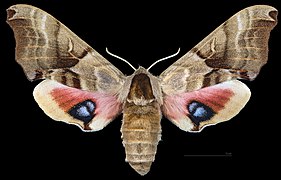Smerinthus jamaicensis
| Smerinthus jamaicensis | ||||||||||||
|---|---|---|---|---|---|---|---|---|---|---|---|---|

Moth from the side |
||||||||||||
| Systematics | ||||||||||||
|
||||||||||||
| Scientific name | ||||||||||||
| Smerinthus jamaicensis | ||||||||||||
| ( Drury , 1773) |
Smerinthus jamaicensis is a butterfly ( moth ) from the family of hawkmoths (Sphingidae).
features
butterfly
The moths have a fore wing length of 21 to 39 millimeters. They have the classic coloration for butterflies of the genus Smerinthus , but can be distinguished relatively well from the related species on the basis of the pattern on the front wings. The tip of the forewings has a dark brown crescent that is bordered white on the inside. A broad, dark brown wipe runs parallel to the body between the postmedial and antemedial band. A pale, light discal line points vertically to the forewing leading edge. Based on these patterns, the species can be easily distinguished from Smerinthus cerisyi and Smerinthus saliceti .
The basic color is somewhat variable, whereby butterflies from the north of the distribution area tend to be darker in color. The blue eye-spot on the hind wings can also be different. It can be divided into two or three parts, or it can be undivided.
Caterpillar
The caterpillars have a blue-green to lime-green basic color. Their bodies are heavily spotted with white and they have a coarsely structured, mostly blue anal horn . The animals have a pair of yellow stripes on their faces and six whitish stripes on the sides of their bodies. The lateral stripes each begin at the front of a segment, approximately at the level of the spiracles, and run dorsolaterally to the back of the next segment. The last stripe that runs to the anal horn is more powerful. The caterpillars are very variable in their color. There are those that are covered with reddish spots, which gives a resemblance to the caterpillars of the genus Paonias . In some individuals, a fine subdorsal line is formed that begins at the front edge of the thorax and extends over the second and third abdominal segments.
Doll
The pupa is colored chestnut to dark brown. Their surface is quite smooth and somewhat shiny. The very broad cremaster at the base is black. It is very coarsely structured, has small thorns on the edges and ends in a blunt point.
Occurrence
The species is the only one of its kind found in the southeast and much of the Great Plains of the United States. The distribution area extends north over New England and the Great Lakes. In eastern Canada, the species is common in the provinces on the Atlantic coast and occurs north of at least to Cartwright and Labrador City . In the west, the distribution area extends over the south of Quebec north at least to the central area of Ontario, Manitoba and large parts of Saskatchewan. In Alberta the species occurs north to Zama City and Fort Chipewyan , west to Lower Post in British Columbia and Watson Lake in Yukon.
The animals predominantly inhabit deciduous forests, but they can also be found in areas that are characterized by intensive agriculture. There they colonize microhabitats along fences or low, moist hollows with willow vegetation.
Way of life
The adults do not eat. Your flight activity begins after midnight at the earliest. They like to fly to artificial light sources at night in summer.
Flight and caterpillar times
In the north, the species occurs in one generation per year. In a study in Saskatchewan, 60 miles north of Saskatoon , where males were attracted with pheromones, the moths were observed from May 23 to July 23. In Nova Scotia the species has been recorded from May 22nd to August 16th, whereby it is assumed that this also includes only one generation. How many generations will be trained in the southern United States is unclear. The moths occur there from March to early August (North Florida). In Louisiana, the species occurs largely throughout the year, but mostly between March and October, with the maximum in July and August.
Food of the caterpillars
Most caterpillar records come from willow family (Salicaceae), especially willow ( Salix ). Occasionally one finds caterpillars from Canada, south to Kansas also on elms ( Ulmus ). There is still isolated evidence of other plant species, but the predominant preference for willow plants is evident.
development
The females lay their eggs one by one. The hatching caterpillars are loners. Pupation takes place in a flat chamber in the ground.
Taxonomy and systematics
When Dru Drury first described the species in 1773, he did so using a moth of a color variant in which an undivided blue eye-spot was formed on the hind wings. Mostly Smerinthus jamaicensis occurs with a split blue eye spot, whereby this "form" was first described by Say in 1824 as Forma geminatus and due to its frequency this name became more common. Forbes even considered the form originally first described by Drury in 1948 as a naturally occurring hybrid. It was not until 1971 that Hodges found that the two were forms of the same species, which led to the name jamaicensis becoming increasingly established.
The specific epithet jamaicensis is derived from the locality Drurys in "Jamaica", whereby only Rothschield & Jordan in 1903 came to the realization that it must be Jamaica (New York City) , especially since the species does not occur in the Antilles .
supporting documents
Individual evidence
- ↑ a b c d e f g h i j k l James P. Tuttle: The Hawkmoths of North America, A Natural History Study of the Sphingidae of the United States and Canada. The Wedge Entomological Research Foundation, Washington, DC 2007, ISBN 978-0-9796633-0-7 , pp. 116f.
literature
- James P. Tuttle: The Hawkmoths of North America, A Natural History Study of the Sphingidae of the United States and Canada. The Wedge Entomological Research Foundation, Washington, DC 2007, ISBN 978-0-9796633-0-7 .



